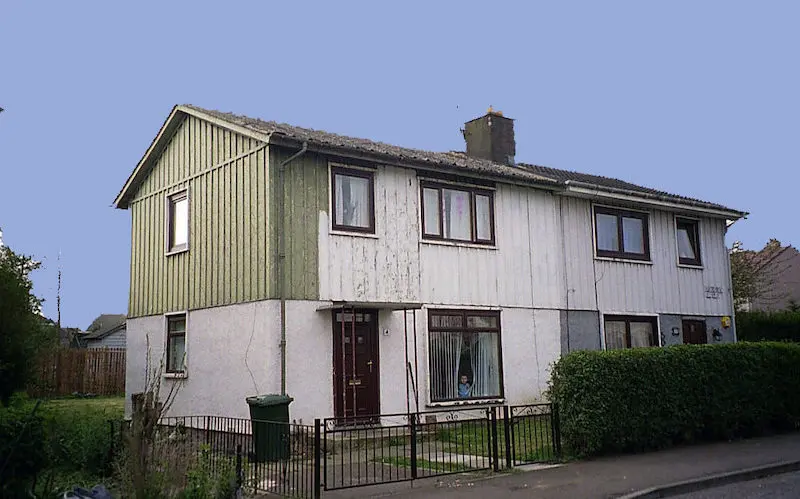In the aftermath of World War II, Britain faced a severe housing shortage. To address this crisis, the government implemented various initiatives to rapidly construct new homes. One such solution was the British Iron and Steel Federation (BISF) house. These unique properties have since become a notable part of the UK’s housing landscape, with their distinct appearance and construction methods. This comprehensive guide will explore everything you need to know about BISF houses, from their origins to their current status in the property market.
What are BISF houses?
BISF houses were developed as part of the post-war prefabricated housing program. The British Iron and Steel Federation, in collaboration with architect Sir Frederick Gibberd, designed these houses to be quickly and efficiently constructed using readily available materials.
Construction Method
BISF houses feature a steel frame structure, with external walls typically made of steel sheeting on the upper floor and concrete panels on the ground floor. The roof is usually covered with steel sheeting or tiles. This construction method allowed for rapid assembly on site, with most of the components prefabricated in factories.
Distinctive Features
Some key characteristics of BISF houses include:
- A distinctive flat or low-pitched roof
- Large windows, often in a horizontal arrangement
- External walls with a corrugated or ribbed appearance on the upper floor
- A rendered or pebbledash finish on the ground floor
- Internal party walls made of steel framing and plasterboard
Can I get a mortgage on a BISF house?
Mortgage Availability
Obtaining a mortgage for a BISF house can be more challenging than for a traditional brick-built property. Many lenders consider BISF houses to be non-standard construction, which can affect their willingness to offer mortgages.
Factors Affecting Mortgage Approval
Several factors influence a lender’s decision:
- The condition of the property
- Any modifications or repairs carried out
- The lender’s specific policies on non-standard construction
- The results of a specialist survey
Specialist Lenders
Some lenders specialize in mortgages for non-standard properties, including BISF houses. These lenders may offer more favorable terms and be more understanding of the unique aspects of BISF construction.
What are the pros and cons of BISF properties?
Advantages of BISF Houses
- Affordability: BISF houses are often priced lower than comparable traditional homes.
- Spacious interiors: The design typically includes generous room sizes and high ceilings.
- Large windows: The abundance of natural light is a common feature.
- Potential for renovation: Many BISF houses can be upgraded and modernized.
- Historical interest: These properties represent an important period in British architectural history.
Disadvantages of BISF Houses
- Insulation challenges: The steel frame construction can lead to poor thermal efficiency.
- Potential structural issues: Some BISF houses may suffer from corrosion of the steel frame.
- Limited mortgage options: Financing can be more difficult to obtain.
- Resale concerns: The non-standard construction may limit the pool of potential buyers.
- Maintenance requirements: Specialized knowledge may be needed for repairs and upgrades.
When were most BISF houses built?
Construction Period
The majority of BISF houses were constructed between 1946 and 1952, as part of the post-war rebuilding effort. However, some continued to be built into the early 1960s.
Number of BISF Houses
It is estimated that approximately 31,500 BISF houses were built across the United Kingdom. These properties were distributed throughout England, Wales, and Scotland, with concentrations in areas that experienced significant bombing during the war.
Regional Variations
While the basic design of BISF houses remained consistent, there were some regional variations in terms of external finishes and minor structural details. These variations often reflected local building practices and available materials.
Can I extend or renovate a BISF house?
Renovation Possibilities
BISF houses can be renovated and modernized, but it’s crucial to approach any modifications with care and expertise.
Common Renovation Projects
- Insulation upgrades: Adding external wall insulation can significantly improve energy efficiency.
- Roof replacements: Many BISF houses benefit from new roofing systems.
- Window replacements: Installing modern, energy-efficient windows can enhance comfort and appearance.
- Internal remodeling: The open plan layout of many BISF houses allows for flexible interior design.
Homeowners should also explore options for HOMEOWNER’S INSURANCE IN HIGH RISK AREAS to ensure comprehensive coverage.
Extension Considerations
Extending a BISF house is possible but requires careful planning:
- Structural integrity: The steel frame must be considered in any extension plans.
- Planning permission: Local authorities may have specific guidelines for BISF house modifications.
- Professional expertise: Engage architects and builders familiar with BISF construction.
Renovation Grants
Some local authorities and housing associations offer grants or assistance for renovating BISF houses, particularly for energy efficiency improvements.
Can I sell a BISF house?
Marketability
BISF houses can be sold, but there are some factors that may affect their marketability:
- Buyer perception: Some potential buyers may be hesitant due to the non-standard construction.
- Mortgage availability: The limited financing options can reduce the pool of potential buyers.
- Property condition: Well-maintained and modernized BISF houses tend to sell more easily.
- Location: As with any property, location plays a significant role in saleability.
Strategies for Selling
To improve the chances of a successful sale:
- Obtain a specialist survey to reassure potential buyers
- Highlight any renovations or improvements made to the property
- Be prepared to educate buyers about the unique aspects of BISF houses
- Consider targeting buyers who appreciate the historical significance of these properties
Professional Assistance
Engaging a real estate agent with experience in selling non-standard properties can be beneficial when listing a BISF house for sale.
FAQs About BISF Houses
Are BISF houses energy efficient?
Originally, BISF houses were not particularly energy efficient due to their steel frame construction and limited insulation. However, many have been upgraded with modern insulation techniques, such as external wall insulation, which can significantly improve their energy efficiency. With proper renovations, a BISF house can achieve good energy performance.
How long do BISF houses last?
BISF houses were initially designed with a lifespan of about 60 years. However, many have surpassed this expectation and continue to provide comfortable homes. With proper maintenance and timely repairs, particularly to prevent corrosion of the steel frame, BISF houses can have a comparable lifespan to traditional brick-built homes.
Are BISF houses safe?
Yes, BISF houses are generally safe when properly maintained. The steel frame construction provides good structural integrity. However, it’s important to address any signs of corrosion promptly and ensure that any modifications are carried out by professionals familiar with BISF construction methods.
Can I insure a BISF house?
Yes, it is possible to insure a BISF house, but you may need to seek out specialist insurers. Some mainstream insurance companies may be reluctant to provide coverage or may charge higher premiums due to the non-standard construction. It’s advisable to shop around and consider brokers who specialize in non-standard property insurance.
Do BISF houses contain asbestos?
Some BISF houses built before the mid-1980s may contain asbestos in certain components, such as roof sheets or internal partition walls. If you suspect the presence of asbestos in a BISF house, it’s crucial to have a professional assessment conducted. Undisturbed asbestos generally doesn’t pose a health risk, but any removal or disturbance should be carried out by licensed professionals.
Conclusion
BISF houses represent an important chapter in Britain’s post-war housing history. While they come with their own set of challenges, these properties also offer unique opportunities for homeowners and investors alike. With proper understanding, maintenance, and modernization, BISF houses can provide comfortable, affordable homes that stand the test of time.
As with any property purchase, it’s essential to conduct thorough research and seek professional advice when considering a BISF house. By understanding the distinctive features, potential issues, and renovation possibilities, you can make an informed decision about whether a BISF house is right for you. For more detailed guidance and expert advice, visit Homijazz.com
Whether you’re a current BISF homeowner, a potential buyer, or simply interested in this slice of architectural history, appreciating the story behind these houses adds depth to their value. As the UK continues to face housing challenges, the lessons learned from the BISF housing program remain relevant, reminding us of the potential for innovative solutions in addressing housing needs.
Keep an eye for more news & updates on Internalinsider.com.










